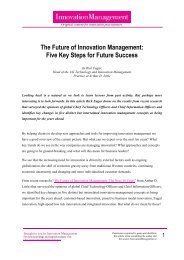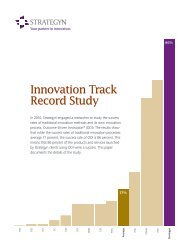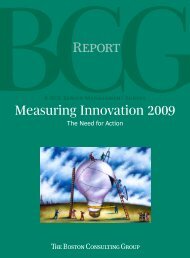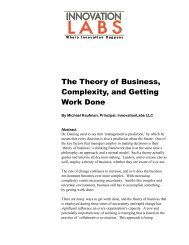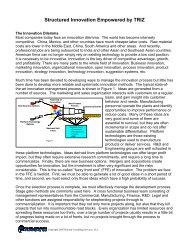the innovation master plan introduction - Innovation Management
the innovation master plan introduction - Innovation Management
the innovation master plan introduction - Innovation Management
You also want an ePaper? Increase the reach of your titles
YUMPU automatically turns print PDFs into web optimized ePapers that Google loves.
<strong>the</strong> <strong>innovation</strong> <strong>master</strong> <strong>plan</strong>: <strong>the</strong> CEO’s guide to <strong>innovation</strong> by Langdon Morrisspecial edition for <strong>Innovation</strong><strong>Management</strong>.com<strong>introduction</strong>7usually seem predictable, and also look a lot like incremental adjustments. They areconsiderably less risky than bold <strong>innovation</strong> bets.Given <strong>the</strong> unpredictable nature of technology-driven competition and <strong>the</strong>acceleration of change that technology has brought, <strong>the</strong> focus on <strong>the</strong> profitability ofexisting operations inevitably leads to a dangerous trap: focusing too much on <strong>the</strong>day to day leaves organizations vulnerable to fundamental change introduced from<strong>the</strong> outside by competitors who risk big, and who occasionally do win big.Compounding <strong>the</strong> difficulty is <strong>the</strong> fact that managers know perfectly well that it’sa mistake to focus so intently on <strong>the</strong> day to day, even as <strong>the</strong>y repeatedly surrender to<strong>the</strong> pressure to do so. They consequently endure enormous anxiety and stress thatresults from <strong>the</strong> tension between short and long term issues.The organizational risks due to this behavior are large. A study by RichardFoster and Sarah Ka<strong>plan</strong> calculated <strong>the</strong> historical death rate for S&P 500 companiesand found that at <strong>the</strong> currently prevailing rate of mortality, a full 75% of 2010’s S&P500 companies will disappear by 2020. That’s 375 out of 500 companies, which willdisappear through merger, bankruptcy, acquisition, or being broken up and sold inpieces. Stated succinctly, if you happen to work for a company that is currently listedin <strong>the</strong> S&P 500, <strong>the</strong> chances are about 3 in 4 that your company will disappear before2020.This statistic should concern you.The vast majority will fail because <strong>the</strong>y don’t adapt to change, to acceleratingchange that is, which will render <strong>the</strong>ir products or services obsolete. In o<strong>the</strong>r words,<strong>the</strong>y’ll be displaced by more innovative firms.Managers know this as well. In a recent McKinsey survey more than 70% of <strong>the</strong>senior executives responding said that <strong>innovation</strong> will be one of <strong>the</strong> top three growthdrivers for <strong>the</strong>ir companies in <strong>the</strong> coming three to five years, as well as – and this isimportant – a key means of adapting to <strong>the</strong> rapid pace of change. 3The companies that endure are often described in terms that we see on magazinecovers, and that we’d all love to be able to apply our own organizations - flexible,adaptable, foresighted, courageous, and yes, innovative. They produce more thanjust short term, incremental, market-share-preserving <strong>innovation</strong>s; <strong>the</strong>y also developand introduce long term, bigger-bet breakthroughs.And what funds <strong>the</strong> <strong>innovation</strong>-seeking work that leads to <strong>the</strong> breakthroughs?Profit from efficient, ongoing operations. And what leads to <strong>the</strong> next generation ofprofit-generating efficiencies? <strong>Innovation</strong>.So in <strong>the</strong> optimal situation, <strong>the</strong> two, operational efficiency and fundamental<strong>innovation</strong>, are inextricably linked.However, while many executives tell us that <strong>the</strong>y’re working on incremental<strong>innovation</strong>s and big breakthroughs, if you observe what <strong>the</strong>ir companies actually do,and <strong>the</strong> products and services <strong>the</strong>y bring to market, you’ll see a heavy bias toward <strong>the</strong>incremental, and a painful shortage of breakthroughs.If you ask <strong>the</strong>m about it, and I’ve asked a great many, <strong>the</strong>y’ll readily admit that<strong>the</strong>y’re short on potential breakthroughs, and overloaded with incremental ideas.They’re hoping, sometimes desperately, that change doesn’t catch up with <strong>the</strong>m, that3 Joanna Barsh, Marla Capozzi and Jonathan Davidson. “Leadership and <strong>Innovation</strong>.” McKinseyQuarterly, 2008, no 1.www.<strong>innovation</strong>management.se





